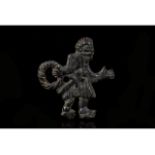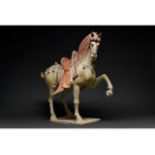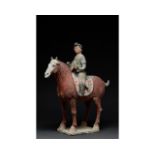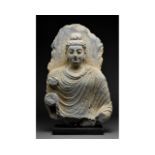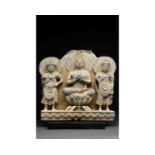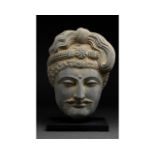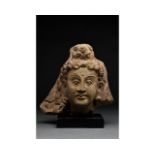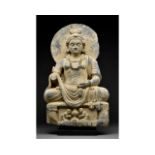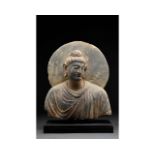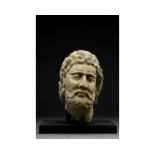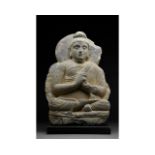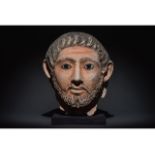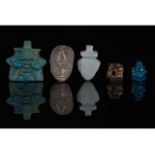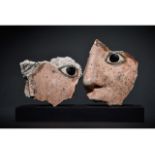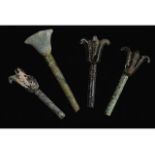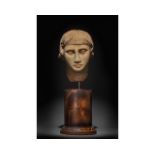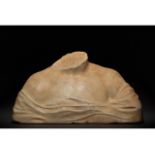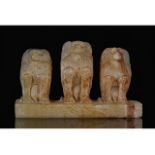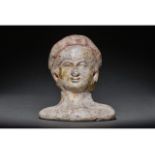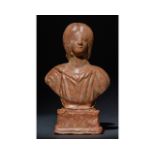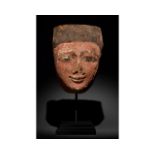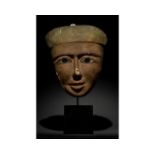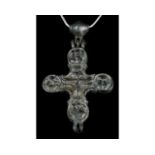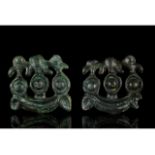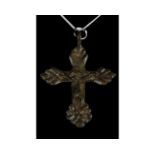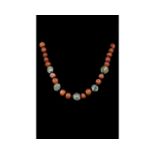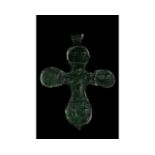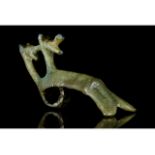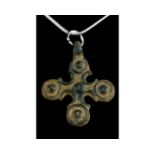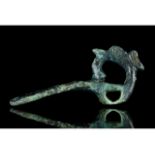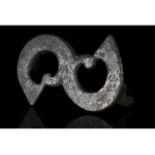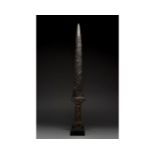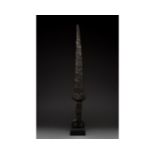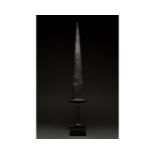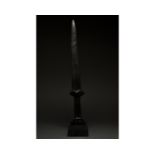Filtered by:
- Category
- List
- Grid
A subscription to the Price Guide is required to view results for auctions ten days or older. Click here for more information
Ca. 700-900 AD. Viking. A rare bronze figure depicting the legendary hero Sigurd who famously slew the dragon Fáfnir. Sigurd, in a military outfit...
Ca. 618-907 AD. Chinese Tang Dynasty. A beautiful pottery figure of a prancing horse. The spirited horse is shown with left foreleg raised, red ma...
Ca. 618-907 AD. Chinese Tang Dynasty. An extremely fine moulded terracotta figurine of a female court musician shown on horseback while playing a ...
GANDHARA SCHIST TORSO OF BUDDHA
Ca. 100-300 AD. Gandharan. A schist stone torso of a Buddha. He is depicted wearing a flowing robe (samghati) and a topknot (ushnisha), with losse...
Ca. 100-300 AD. Gandharan. A schist stone panel of a Buddha flanked by two Bodhisattvas. Each has a large circular halo behind his head. The centr...
Ca. 100-300 AD. Gandharan. A schist stone head of a Buddha. He is depicted with wavey hair gathered up in a topknot above a headband. His face cha...
GANDHARA SCHIST STONE HEAD OF BUDDHA
Ca. 100-300 AD. Gandharan. A schist stone head of a Buddha. He is depicted with curly ringlets of hair gathered up in a topknot (ushnisha). He has...
Ca. 100-300 AD. Gandharan. A schist stone statue of a Buddha. He is depicted wearing a flowing robe (samghati) draped elegantly around his left sh...
Ca. 100-300 AD. Gandharan. A schist stone torso of a Buddha. He is depicted wearing a flowing robe and a topknot (ushnisha). He is characterised b...
Ca. 300-100 BC. Graeco-Bactrian. A marble head of a man with a thick beard, hanging down in broad locks along the cheeks. His face is carefully mo...
Ca. 100-300 AD. Gandharan. A schist stone depicting a seated Buddha in a lotus pose - the right leg folded in first and the left leg on top. The B...
Ca. 323 BC-395 AD. Graeco-Roman Period. A Greco-Egyptian ceramic head of a man. The piece is stunningly life-like. The man depicted has wavy locks...
Ca. 664-30 BC. Late Period - Ptolemaic Dynasty. A group of four amulets and a statuette head. These include a blue-glazed faience head of the god ...
Ca. 323 BC-395 AD. Graeco-Roman Period. Ceramic fragments of a face. These come from a sculptural head in the Classical style. They are decorated ...
Ca. 664-30 BC. Late Period - Ptolemaic Dynasty. A group of four glaze faience sceptres and rods. Each has a long cylindrical rod topped with a dif...
EGYPTIAN MARBLE HEAD OF A WOMAN
Ca. 323 BC-395 AD. Graeco-Roman Period or later. A marble head of a woman on a modern stand. This elegant piece principally uses the Classical sty...
Ca. 1700-1800 AD. A neoclassical marble bust of a woman in roman style, missing its head. It is rendered in a life-like Classical style, with a to...
Ca. 1550-1077 BC. New Kingdom. A sculpture of three baboons. The trio sits upon a long and thick plinth. Each baboon is shown seated, and the midd...
GANDHARAN GILDED MARBLE BUST
Ca. 100BC-300 AD. Gandharan / Greco - Bactrian . A rare small marble bust depicting a male figure. His face is modelled with a serene expression a...
Ca. 193 - 211 AD. Roman. This beautifully draped bust shows Julia Domna, the wife of Emperor Septimius Severus, with sensitively rendered facial f...
EGYPTIAN WOODEN MUMMY MASK
Ca. 1069-332 BC. Third Intermediate Period - Late Period. A wooden coffin face / mummy mask decorated in polychrome. The face is finely detailed w...
EGYPTIAN WOODEN MUMMY MASK
Ca. 1069-332 BC. Third Intermediate Period - Late Period. A wooden coffin face / mummy mask decorated in polychrome. The face is finely detailed w...
MEDIEVAL BRONZE RELIQUARY CROSS
Ca. 1000-1300 AD. Medieval Europe. A finely modelled cast bronze reliquary cross composed of three parts: two crosses that fit together, a large l...
Ca. 500-300 BC. Scythian culture. Two bronze mounts in the form of abstract animals with circular loops at the back; excellent condition. Zoomorph...
MEDIEVAL BRONZE CROSS PENDANT
Ca. 1100-1300 AD. Crusaders Period. A bronze crucifix pendant comprising four arms with rounded terminals and incised linear decorations. In addit...
Ca. 100-300 AD. Roman. A restrung and fully wearable necklace made of a single string of white and blue glass beads and carnelian beads. Necklaces...
Ca. 1000-1300 AD. Medieval Western Europe. A beautiful bronze cross featuring rounded arms and mould-beaten decoration. The cross bears extensive ...
Ca. 500-300 BC. Scythian culture. A bronze fitting comprising an axe head-shaped body and two integral loops with zoomorphic decoration (perhaps a...
MEDIEVAL BRONZE CROSS PENDANT
Ca. 1000-1300 AD. Medieval Western Europe. A bronze cross with four equal-length arms with ribbed decoration. The centre of the cross and each of ...
Ca. 500-300 BC. Scythian culture. A bronze mount in the form of an abstract animal; good condition. Zoomorphic mounts were affixed to garments of ...
Ca. 100-200 AD. Roman. A rare swirling S-shaped brooch; the terminals of the S are joined together through small comma-shaped bronze extensions. G...
ANCIENT AKINAKES IRON SWORD
Ca. 600-400 BC. Eastern Mediterranean. A very well preserved short iron sword of the akinakes type (Greek 'ἀκῑνάκης') with a pointed bevelled blad...
ANCIENT AKINAKES IRON SWORD
Ca. 600-400 BC. Eastern Mediterranean. A well preserved short iron sword of the akinakes type (Greek ἀκῑνάκης') with a pointed bevelled blade, bow...
ANCIENT AKINAKES IRON SWORD
Ca. 600-400 BC. Eastern Mediterranean. A well preserved short iron sword of the akinakes type (Greek ἀκῑνάκης') with a pointed bevelled blade, wid...
ANCIENT AKINAKES IRON SWORD
Ca. 600-400 BC. Eastern Mediterranean. A well preserved short iron sword of the akinakes type (Greek ἀκῑνάκης') with a pointed blade, bow-shaped g...

